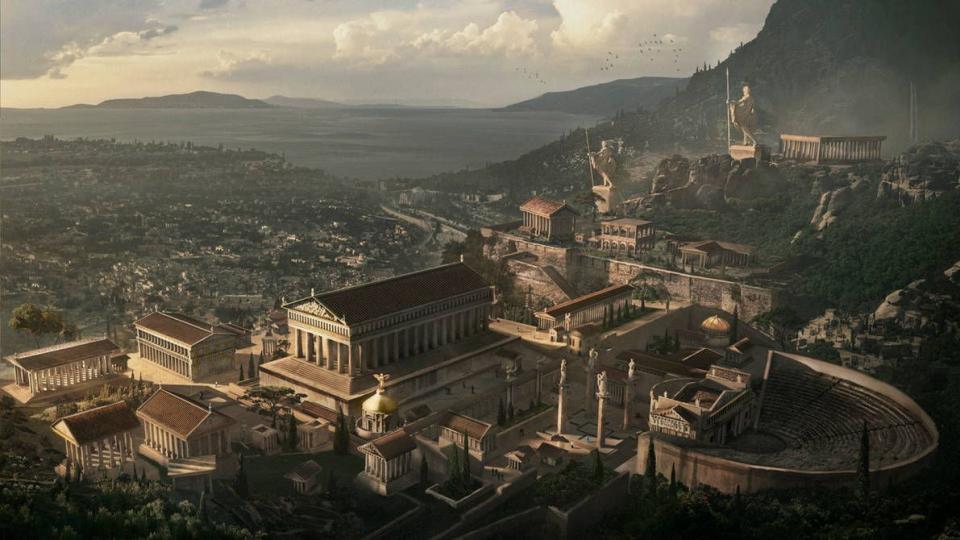
Sparta
Sparta is a city-state in Lakonia, Greece, home to a warrior society where all designated were trained from childhood to serve throughout their lives in a purely militaristic capacity. This specialization produced some of the greatest warriors of their time, and the martial might of Sparta's soldiers held a legendary prestige across Greece.
In most traditions, Sparta was formed by the surrounding villages of Pitana, Mesoa, Limnai and Kynosoura, which were settlements established by Dorian Greeks who migrated to Lakonia during the Greek Dark Ages.
In 480 BCE, Sparta was led by King Leonidas who fell at the Battle of Thermopylae during the Second Persian invasion of Greece. The Greeks were nonetheless victorious in the war, and in the aftermath, Athens emerged as the hegemonic power as leader of the Delian League.
During this period, Sparta and Athens became archenemies. To counter the Delian League, the former established an alliance of its own known as the Peloponnesian League. Open conflict erupted in 431 BCE with the Peloponnesian War. During this period of time, Sparta was jointly ruled by Archidamos of the Eurypontid dynasty and Pausanias of the Agiad dynasty.
Culture
An retelling from Stratigos Duris teaching his unit about their culture:
- The population of Sparta consisted of:
- Spartans, or Spartiates: Those who were full citizens.
- Perioeci, whose name means “dwellers-around”: Those who worked as craftsmen and traders, and built weapons for the Spartans.
- Helots: Indentured Servants.
- Mothakes: Non-citizen inhabitants of Sparta.
- Spartiates made up the bulk of the governmental positions in Sparta. Most women chose to manage their homes while most of the men were conscripted into the military. Majority of the farming, construction, household chores, and other kinds of manual labor were performed by the Helots. Whereas, majority of the crafting, trading, and other skilled labor was performed by the Perioeci.
- All healthy Spartan citizens participated in the compulsory state-sponsored education system, which emphasized obedience, endurance, courage, and self-control.
- A Spartan was taught that loyalty to the state came before everything else, including one’s family.
- Sparta was centered on a warrior culture and as such much of the focus of the culture was on training for combat and equipping the military.
- From the age of seven, males had a militaristic upbringing known as the agōgē where they were separated into age groups and lived in barracks. These youths pursued rigorous athletic and military training which became even more demanding from the age of 20, when they joined common mess halls (syssition) where they often formed homoerotic relations. The girls who showed combat potential lived in gender specific barracks and also pursued rigorous and athletic training to make them prepared for military life.
- Spartan women had a reputation for being independent-minded, and enjoyed more freedoms and power than their counterparts throughout ancient Greece.
- Spartan women who showed high potential in combat skills were allowed to join the military.
- Spartan women were allowed to own and manage property and many of the Spartan women chose to manage their homes rather than join the military.
- Marriage was important to Spartans. Spartan women had their heads shaved; they kept their hair short after they wed.
Political Structure
An excerpt from Ephor Alexa on the Political structures of Sparta:
- Sparta was an oligarchic city-state, ruled by two hereditary kings equal in authority and from two separate families: Pausanias is the Agaid King and Archidamus II is the Eurypontid king.
- One of them led the army on campaign and the other remained behind in Sparta to lead the city.
- The kings also sat on the council of elders known as the Gerousia.
- This body consisted of 28 citizens over the age of 60 who held the position for life. The Gerousia led the citizen assembly, proposing issues on which to vote and it was also the highest court in Sparta.
- There was also an assembly of all Spartiates that had either reached the age of serving in the army or after reaching the age of 30. This assembly (the Ekklēsia) met once a month and was open to all citizens who voted by the simple method of shouting. This assembly annually voted for supervisors, or Ephors.
- The Ephors were an executive committee of five ephors (ephoroi) chosen by lot from the citizen body.
- They had an executive role in the assembly, could call the Gerousia to meet, and could even make a final decision if the two kings could not agree.
An retelling from Stratigos Duris teaching his new officers about the structures of the Spartan Military:
- The Spartans’ constant military drilling and discipline made them skilled at the ancient Greek style of fighting in a phalanx formation. In the phalanx, the army worked as a unit in a close, deep formation, and made coordinated mass maneuvers. No one soldier was considered superior to another.
- Going into battle, a Spartan soldier, or hoplite, wore a large bronze helmet, breastplate and ankle guards, and carried a round shield made of bronze and wood, a long spear, and sword.
- Spartan warriors were also known for their long hair and red cloaks.
- Hoplite Army
- The tough militaristic training of the youth resulted in a professional Hoplite army capable of relatively sophisticated battle maneuvers which made them feared throughout Greece.
- Sparta has a notable lack of fortifications.
Basic History
An excerpt from Ephor Alexa on the the History of Sparta:
- Sparta was located in the fertile Eurotas valley of Laconia in the southeast Peloponnese. The area was first settled in the Neolithic period and an important settlement developed in the Bronze Age.
- It is said that the founder of the ancient city was Lacedaemon, a son of Zeus, who gave his name to the region and his wife's name to the city.
- Sparta, under Cleomenes (c. 520-490 BCE), overthrew the tyrants of Athens but the resulting democracy put a stop to any Spartan ambitions in the city. Sparta was, however, an ally with Athens in the defense of Greece against the invasion of Persian king Xerxes, and fought with distinction at Thermopylae in 480 BCE and at Plataea one year later. From 480 to 460 BCE regional rivalries and revolts by the helots damaged Sparta and worse were to follow when rivalry with Athens developed into the First Peloponnesian War from c. 460 to 446 BCE.
- In early 431 BCE the Spartans voted to begin a war with Athens.
An explanation from Ephor Alexa to a newly arrived diplomat:
- Two powerful allies of Sparta were part of the Peloponnesian League: Corinth and Elis (also city-states).
- Other parts of the Peloponnesian League were Simah, Epidaurus, Megara, and Aegina.
- The members of the Peloponnesian League were autonomous. They were committed only in the case of war against a common enemy to give a certain number of soldiers and recognize the Spartans' supreme military command.

